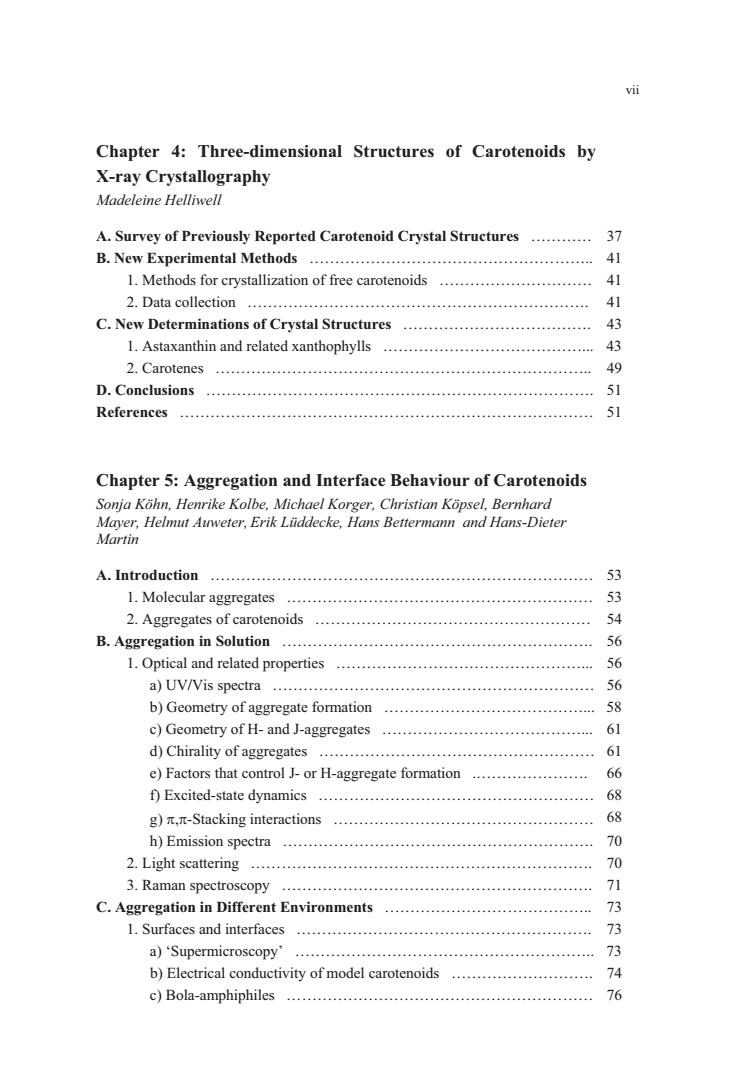正在加载图片...

vi Chapter 4:Three-dimensional Structures of Carotenoids by X-ray Crystallography Madeleine Helliwell A.Survey of Previously Reported Carotenoid Crystal Struetures.37 B.New Experimental Methods …41 1.Methods for crystallization of free carotenoids 2.Data collection ....... C.New Determinations of Crystal Structures 43 1.Astaxanthin and related xanthophylls 43 2 Carotenes 49 D.Conclusions 51 References Chapter 5:Aggregation and Interface Behaviour of Carotenoids Sonja Kohn,Henrike Kolbe,Michael Korger,Christian Kopsel,Bernhard Mayer,Helmut Auweter,Erik Liiddecke,Hans Bettermann and Hans-Dieter Martin A.Introduction 53 1.Molecular aggregates 2.Aggregates of carotenoids B.Aggregation in Solution 56 1.Optical and related properties a)UV/Vis spectra 56 b)Geometry of aggregate formation ““+4……+44小+4“+440+4…4小444…*4……4 58 c)Geometry of H-and J-aggregates 61 d)Chirality of aggregates 61 e)Factors that control J-or H-aggregate formation.. 6 f Excited-state dynamics 68 g))π,r-Stacking interactions 68 h)Emission spectra 2.Light scattering 70 3 Raman spectroscopy C.Aggregation in Different Environments ……4+444……+…44…”*44+*+”…444 3 I.Surfaces and interfaces ......................................................... 73 a)‘Supermicroscopy 73 b)Electrical conductivity of model carotenoids......... 74 c)Bola-amphiphiles 76vii Chapter 4: Three-dimensional Structures of Carotenoids by X-ray Crystallography Madeleine Helliwell A. Survey of Previously Reported Carotenoid Crystal Structures ………… 37 B. New Experimental Methods ……………………………………………….. 41 1. Methods for crystallization of free carotenoids ………………………… 41 2. Data collection …………………………………………………………. 41 C. New Determinations of Crystal Structures ………………………………. 43 1. Astaxanthin and related xanthophylls …………………………………... 43 2. Carotenes ……………………………………………………………….. 49 D. Conclusions …………………………………………………………………. 51 References ……………………………………………………………………… 51 Chapter 5: Aggregation and Interface Behaviour of Carotenoids Sonja Köhn, Henrike Kolbe, Michael Korger, Christian Köpsel, Bernhard Mayer, Helmut Auweter, Erik Lüddecke, Hans Bettermann and Hans-Dieter Martin A. Introduction ………………………………………………………………… 53 1. Molecular aggregates …………………………………………………… 53 2. Aggregates of carotenoids ……………………………………………… 54 B. Aggregation in Solution ……………………………………………………. 56 1. Optical and related properties …………………………………………... 56 a) UV/Vis spectra ……………………………………………………… 56 b) Geometry of aggregate formation …………………………………... 58 c) Geometry of H- and J-aggregates …………………………………... 61 d) Chirality of aggregates ……………………………………………… 61 e) Factors that control J- or H-aggregate formation .………………….5 66 f) Excited-state dynamics ……………………………………………… 68 g) ,-Stacking interactions …………………………………………… 68 h) Emission spectra ……………………………………………………. 70 2. Light scattering …………………………………………………………. 70 3. Raman spectroscopy ……………………………………………………. 71 C. Aggregation in Different Environments ………………………………….. 73 1. Surfaces and interfaces …………………………………………………. 73 a) ‘Supermicroscopy’ ………………………………………………….. 73 b) Electrical conductivity of model carotenoids ………………………. 74 c) Bola-amphiphiles …………………………………………………… 76 ��